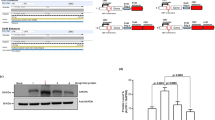Summary
To construct the eukaryotic expression plasmid of human PRX3 and measure its expression in the HEK-293FT cells, the full-length coding region of human PRX3 was cloned by PCR and inserted into the eukaryotic expression vector pcDNA4-Xpress (A). HEK-293FT cells were transientely transfected with the recombinant plasmid. Western blot and immuofluoresence were used to detect the expression of the fusion protein. In the experiment, restriction analysis identified the construction of the recombinant plasmid and the inserted sequence was identical with that published on GenBank. Western blot and immunofluorescence confirmed the exprression of the recombinant protein in transferted HEK-293FT cells. It was concluded that the eukaryotic expression plasmid of human PRX3 was constructed successfully and the recombinant could be expressed efficiently in HEK-293FT cells, which provides a sound basis for the further study on human PRX3.
Similar content being viewed by others
References
Tsuji K, Copeland NG, Jenkins NAet al. Mammalian antioxidant protein complements alkylhydroperoxide reductase (ahpC) mutation in Escherichia coli. Biochem J, 1995, 307: 377
Shih S F, Wu Y H, Hung C Het al. Abrin triggers cell death by inactivating a thiol-specific antioxidant protein. J Biol Chem, 2001, 276: 21870
Altschul S F, Gish W, Miller Wet al. Basic local alignment search tool. J. Mol. Biol., 1990, 215: 403
Watabe S, Kohno H, Kouyama Het al. Purification and characterization of a substrate protein for mitochondrial ATP-dependent protease in bovine adrenal cortex. J Biochem (Tokyo), 1994, 115: 648
Fujii J, Ikeda Y. Advances in our understanding of peroxiredoxin, a multifunctional, mammalian redox protein. Redox Rep, 2002, 7: 123
Wood Z A, Schroder E, Robin H Jet al. Structure, mechanism and regulation of peroxiredoxins. Trends Biochem Sci, 2003, 28: 32
Araki M, Nanri H, Ejima Ket al. Antioxidant function of the mitochondrial protein SP-22 in the cardiovascular system. J Biol Chem, 1999, 274: 2271.
Wonsey DR, Zeller KI, Dang CV. The c-Myc target gene PRDX3 is required for mitochondrial homeostasis and neoplastic transformation. Proc Natl Acad Sci U S A, 2002, 99: 6649
Choi J H, Kim TN, Kim Set al. Overexpression of mitochondrial thioredoxin reductase and peroxiredoxin III in hepatocellular carcinomas. Anticancer Res, 2002, 22: 3331
Author information
Authors and Affiliations
Additional information
FENG Yan, female, born in 1974. M.D., Ph. D.
Rights and permissions
About this article
Cite this article
Yan, F., Zhao, L., Huiqing, C. et al. Construction of eukaryotic expression plasmid of human PRX3 and its expression in HEK-293FT cells. Current Medical Science 24, 311–313 (2004). https://doi.org/10.1007/BF02861855
Received:
Published:
Issue Date:
DOI: https://doi.org/10.1007/BF02861855




